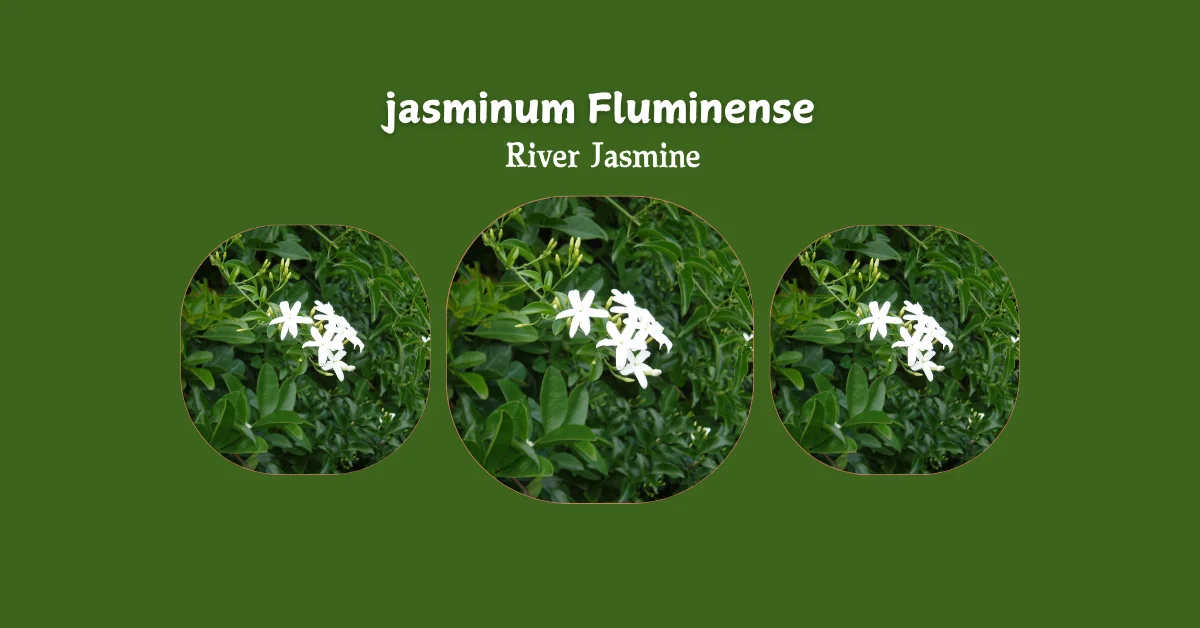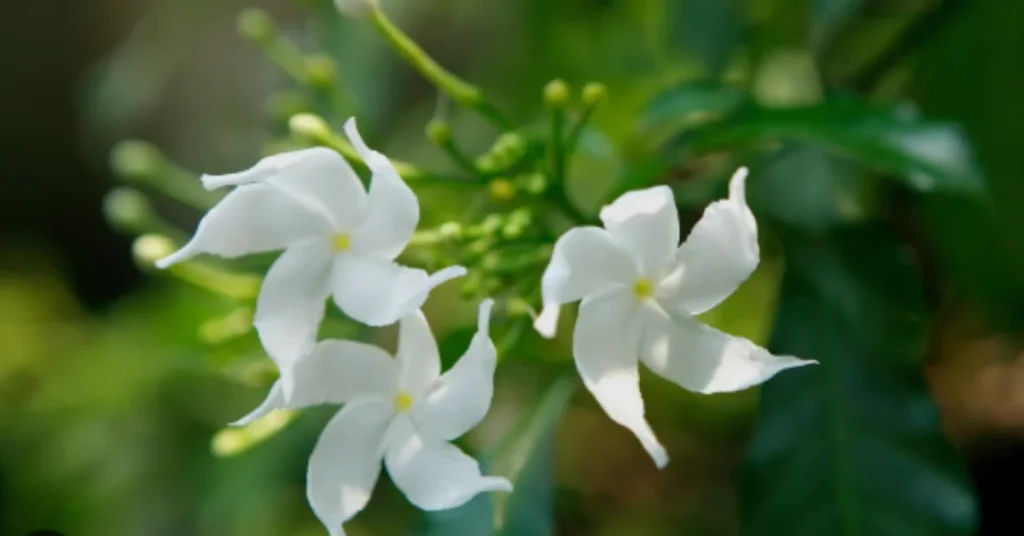Jasminum Fluminense (River Jasmine) – Growing and Uses

The Jasminum Fluminense, also known as River Jasmine or sometimes mistakenly spoken a Brazilian Jasmine, is a flowering plant valued for its fragrant fragrance and delicate beauty. Originally from Brazil, especially the Atlantic Forest region, this evergreen vine belongs to the Oleaceae family. Among its natural habitats are riverbanks, forests, and humid areas, which have warm, tropical climates. Over time, it has invaded pastures, croplands, open spaces in cities, disturbed areas, roadsides, forest edges and gaps, and riverbanks.
Tropical horticulture introduced River jasmine to Florida in the early 1920s, and it has escaped cultivation in South Florida ever since. Various countries in Africa and Arabia are native to this species, while parts of the Americas are invasive. Many Caribbean islands, Central American countries, and Florida have become established with this species. There are large clusters of flowers and leaves, differing from J. dichotomum, which has trifoliate, glabrous leaves. Mostly, it grows in seasonally dry tropical biomes.
Classification Table
| Order | Lamiales |
| Family | Oleaceae |
| Genus | Jasminum |
| Species | Jasminum fluminense |
Habitat
Human-altered environments (yards, abandoned fields, roadsides) are ideal for Jasminum fluminense habitat. Several gardens add this plant because of its lush foliage and profusion of white, star-shaped flowers.
The plant, however, should be handled with caution, as Jasminum fluminense can escape cultivated conditions and establish itself aggressively in the wild.
Growth Habits
Flowers are white, fragrant, and open at night in broad, branched clusters at leaf axils. Its lush foliage and profusion of white, star-shaped flowers make it a popular choice for gardens. Jasminum fluminense typically grows up to 15 meters long and has pubescent stems and petioles.
It is relatively simple to cultivate. Jasminum fluminense plant climbs and twines, which makes it ideal for covering fences, walls, and trellises. It can also smother native vegetation.
Ample moisture is essential, especially during the growing season, but avoid waterlogging, which can lead to root rot.
Leaves
The glossy, dark green leaves provide a lovely background for the blooms. Trifoliate leaves are arranged opposite each other. Leaflets measure up to 7 cm in length and have an acute/acuminate leaf apex and a complete leaf margin. Side leaflets are smaller than terminal leaflets. Several pubescent groups line the abaxial surface of the veins.
Flowers
The terminal and axillary cymes contain complete, perfect, actinomorphic flowers. There are five fused, pubescent sepals in the calyx. A long tube of fused white petals forms the corolla, which has a pubescent throat with 4-9 lobes.
Corollas have two stamens fused to them. The ovary has two locules and one ovule each. Flower styles can be long or short (heterostylous). Flowers bloom all year long, but they are most abundant in spring and summer. Their sweet, intoxicating fragrance attracts bees, butterflies, and other pollinators.
Fruits
When Jasminum fluminense flowers, it produces small, berry-like fruits that turn from green to black as they mature. Birds are attracted to the jasmine fruit and they contribute to its dispersal by consuming the seeds of the plant and then excreting them. Depending on the environmental conditions, the Jasminum fluminense seeds spread rapidly in areas where they are highly viable.
Jasminum Fluminense Care and Cultivation
Sunlight
River Jasmine grows best in bright, direct sunlight. A moderate temperature and moderate level of humidity are ideal for it. In areas with 6–7 hours daily sunlight a day , it thrives best. The best place to grow it is less than one foot away from a south-facing window.
Watering
Make sure the soil is almost totally dry before watering. Ensure the Jasminum fluminense is watered once every 7-9 days interval depending on soil dryness and weather. Water deeply especially during the summer.
Remember, root rot can be caused by overwatering, while leaf drop and poor flowering are caused by underwatering.
Soil Requirements
Well-draining loamy soil is ideal for this plant. Regardless of soil type, this plant thrives best in lightly compacted soil. A slightly acidic to neutral soil, rich in organic matter is good for the plants. Prevent root rot by ensuring the soil dries between watering.
Fertilization
Jasminum fluminense benefits from a balanced, slow-release fertilizer applied in spring. Select a fertilizer with a 10-10-10 ratio of nitrogen, phosphorus, and potassium. For vigorous growth and blooms, fertilize the plant 4-6 times a year during the growing season.
Almost all potting soils provide enough nutrients for new growth in plants. After your Brazilian Jasmine reaches a size of two or one years, repot it to replenish its nutrients.
Pruning
In garden settings, regular pruning is necessary to ensure that Jasminum fluminense maintains its shape and size. Pruning regularly will keep it bushier. Trim back overgrown areas after the flowering season to remove any dead or damaged stems.
Support Structures
A sturdy support structure, such as a trellis and arbor is a good option for Jasminum fluminense when it climbs upwards. Protect newly growing vegetation from becoming tangled or invasive by guiding it along the support.
Propagation
Stem cuttings: Late spring or early summer is the best time to propagate using semi-hardwood cuttings. Plant your cuttings in a well-draining soil mix with at least two nodes. Until roots develop, keep the soil moist.
- Healthy, non-flowering stems of about 4-6 inches in length are best.
- Grasp the stem by the lower two-thirds and remove the leaves.
- Take rooting hormone and dip the cut stem end into it.
- Make a small hole in the potting mix with your finger or a pencil. Place the bottom node of the cutting (where you removed the leaves) into the hole.
- Firm the soil around the cutting gently.
- Keep the cuttings well hydrated. Plastic bags or propagation domes can be used to create a humid environment for root development in pots.
- Avoid direct sunlight and place cuttings in a bright, warm place. It takes 4-6 weeks for the roots to develop.
- Plant your rooted cuttings in individual pots or your garden once roots emerge and new growth appears.
Layerings:
- Choose a healthy stem that reaches the ground.
- Add Compost to the soil where the stem will touch the ground so as to loosen it.
- Root growth can be stimulated by making a tiny nick or wound on the stem’s underside where it contacts the soil.
- Bury the wounded portion of the stem in the soil after it has been bent carefully. Fix it with a landscape pin or rock.
- Maintain a consistently moist soil.
- The layered stem of the parent plant should be carefully severed and transplanted once the roots have developed.
Ecological impact
As an aggressive weed, Jasminum fluminense can displace native species, alter community structures, and alter ecological functions in native plant communities. Both disturbed and undisturbed forests can be completely overrun by these plants.
Jasminum fluminense seeds dispersed by birds and mammals have very high germination rates. It is an aggressive, persistent weed that can climb high into the tree canopy of mature forests, completely engulf native plants.
South Florida hardwood forests have been vigorously invaded by this species.
Jasminum Fluminense Uses
- Decorative vines and fragrant flowers make it an ideal plant for covering unsightly fences, creating privacy screens, or adding romance to a garden.
- A key feature of the Jasminum fluminense plant is its versatility. It creates a charming vertical display when trained to climb arbors, trellises, and fences. It can also be allowed to cascade from hanging baskets or spread as ground cover and add a touch of elegance to patios and balconies.
- In Brazil, Jasminum fluminense is often used as a medicinal plant and in religious ceremonies apart from its ornamental value. Its fragrant flowers are valued in perfumery and aromatherapy.
Medicinal uses: There is limited research on the medicinal uses of Jasminum fluminense. Like other jasmine species especially jasminum sambac, this specie may also have anti-inflammatory effects. Jasmine essential oil is used in skincare products for its potential to hydrate the skin, reduce blemishes, and soothe irritation. The fragrance of flowers may have a positive impact on mental health by reducing feelings of depression and anxiety.
To Sum Up
River Jasmine adds beauty to gardens around the world with its fragrant flowers and lush greenery. However, it can also threaten native ecosystems by causing destructive invasions.
Growing it in a safe region can add a stunning element to the landscape, provided the plant is managed carefully. A focus on control and conservation should be applied where it is invasive, to ensure that local biodiversity isn’t threatened.

I am Yasir Riaz, an Agronomist for more than a decade. Helping local farmers and Gardeners to improve their crops and Gardens and overall productivity. In addition to my work in agriculture, I have also delved into the digital world as an SEO writer and blogger. Through my blog, I aim to educate and inspire others about the Chameli Flower (Jasmine).






